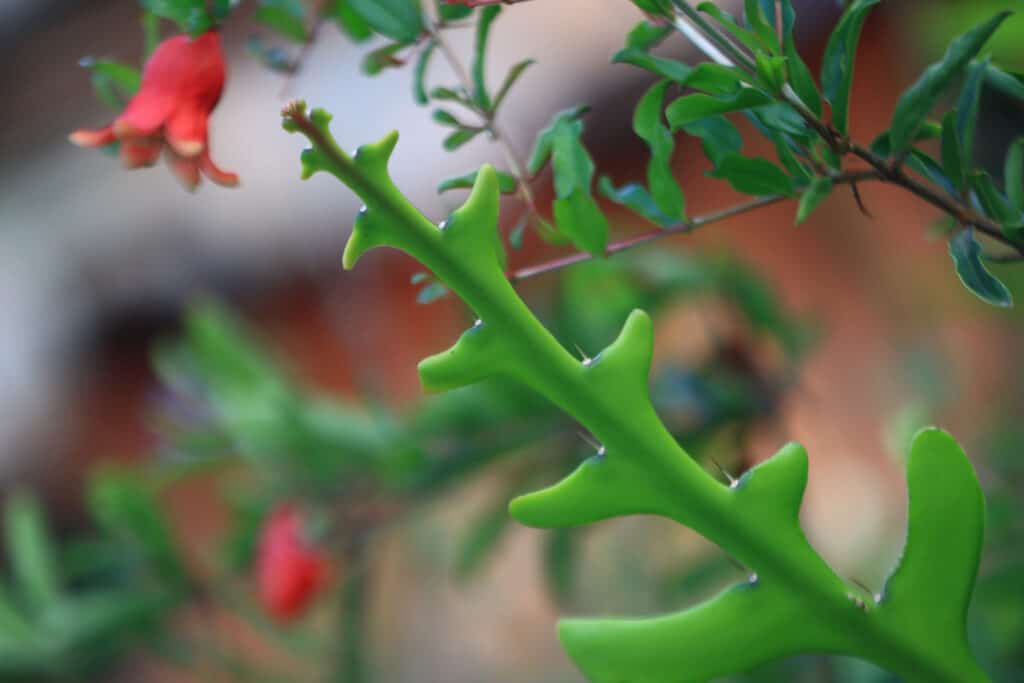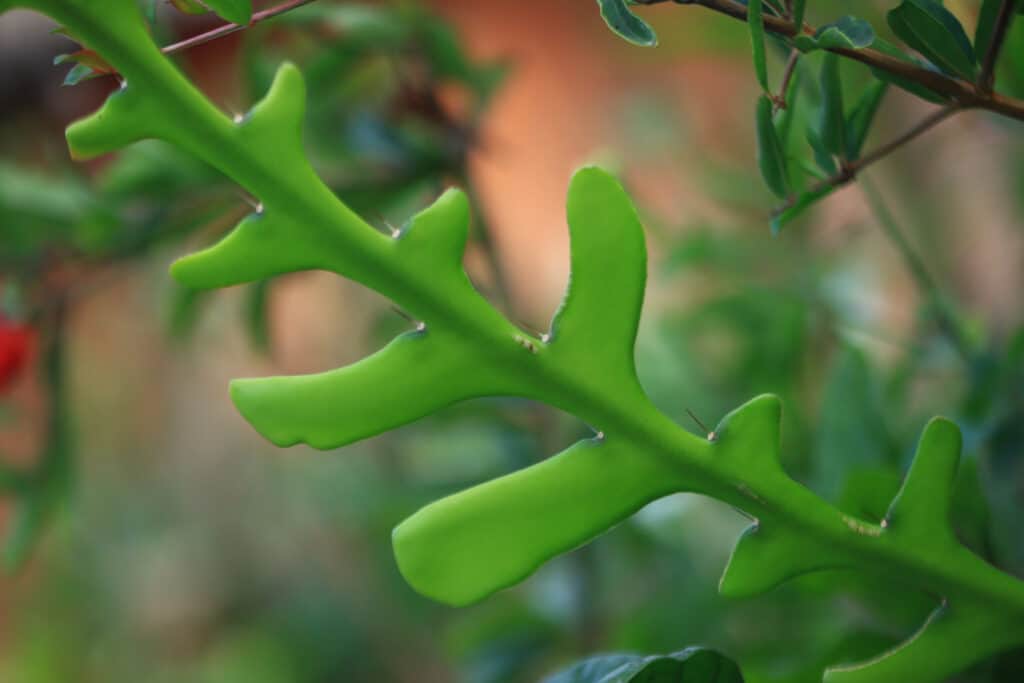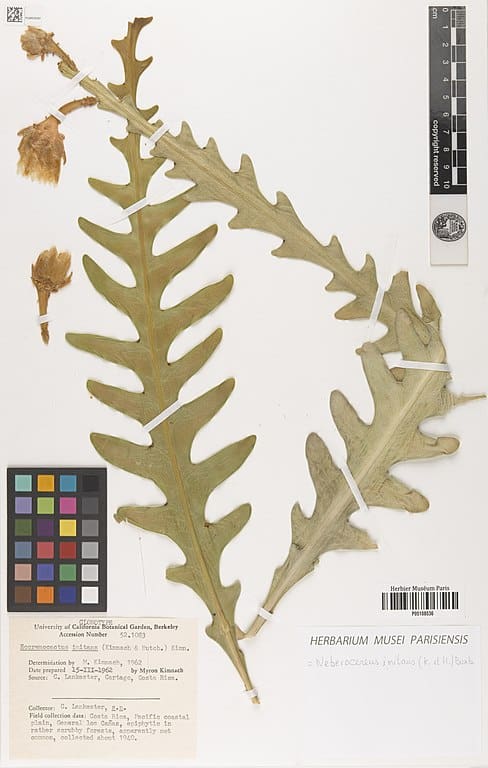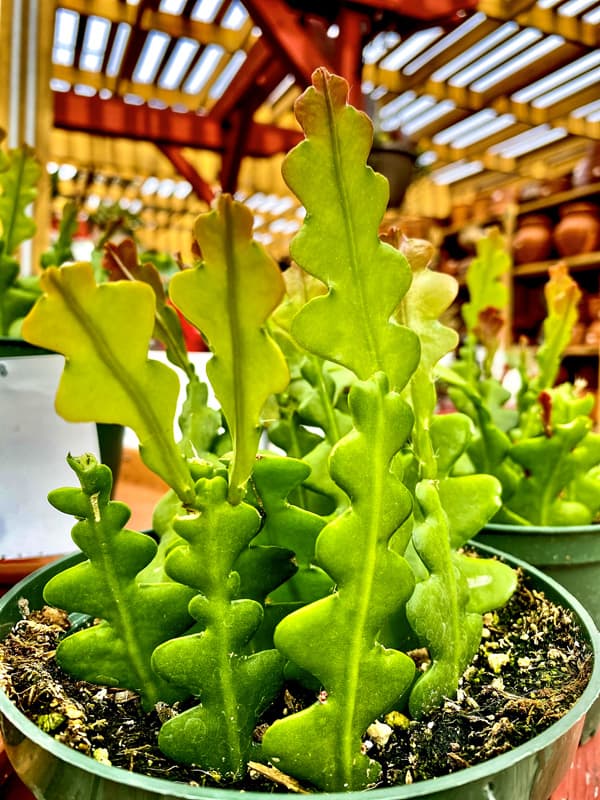You’re probably here because you’re trying to understand the difference between Ric Rac and fishbone cacti or if there is any difference at all.
Well, the answer is more complex. Why? Because, scientifically speaking, Ric Rac is the same thing as fishbone cactus. On the other hand, there are three fishbone cactus species, a fact indicating that the Ric Rac might be the common name for all of them, right? But is it really? You’ll soon find out!
Keep reading to learn everything about the three fishbone species and whether they can be called Ric Rac. We’ve also included key species features that will help you distinguish between these three fishbone cacti.
Also, since we know that fishbone cactus flowers are stunningly beautiful, we’ve added a section on how to enhance blooming, water your plant properly, and what environment it best lives in!
Is Ric Rac Cactus the Same as Fishbone Cactus?

Ric Rac is the same as fishbone cactus.
©iStock.com/Ikhwan Ameer
Yes, Ric Rac is the same as fishbone cactus. It is also called zig-zag cactus because it has zig-zag-shaped or fishbone-shaped stems, making it look like it has leaves.
There are three fishbone cactus species, however. This means all can be called Ric Rac, too, since it’s an alternative name for fishbone. But is it biologically correct? Let’s see!
What Is the Scientific Name for Fishbone Cactus?
Fishbone cactus is often scientifically called Selenicereus anthonyanus. Two other cactus species go by the common name of “fishbone cacti,” however. These are the Disocactus anguliger and the Weberocereus imitans. The three are part of the same family and subfamily (Cactaceae and Cactoideae, respectively) but of different genera. Let’s discuss each in detail to understand which one is, in fact, a fishbone cactus – or if they are all fishbone cacti.
What Is Selenicereus anthonyanus?

The
Selenicereus anthonyanusplant is endemic to southern Mexico’s lowland rainforest.
©RDPixelShop from Tijuana, USA / CC BY-SA 2.0 – License
The Selenicereus anthonyanus plant is often called fishbone cactus, zig-zag cactus, rickrack (or Ric Rac) cactus, and St. Anthony’s rickrack. It is part of the Selenicereus genus. This cactus is endemic to southern Mexico’s lowland rainforest. This species was named after the first person who “investigated” this plant, Harold E. Anthony. He was the first to see it flower. In 1989, the first description of this cactus was published.
What Is Disocactus anguliger?

The
Disocactus anguligerwas previously called
Epiphyllum anguliger.
©iStock.com/Ikhwan Ameer
The Disocactus anguliger is part of the Disocactus genus. It was previously called Epiphyllum anguliger, but molecular research caused scientists to change its taxonomy. Interestingly enough, the term “anguliger” points to their stems’ form, as it translates to “angle bearing.” Unlike the Selenicereus anthonyanus, this plant is rarely called Ric Rac (or rickrack), as people often refer to it as fishbone cactus or zig-zag cactus.
What Is Weberocereus imitans?

The
Weberocereus imitansis part of the
Weberocereusgenus.
©MNHN / CC BY 4.0 – License
The Weberocereus imitans is part of the Weberocereus genus. Unlike the other two species, this cactus is native to Costa Rica and is smaller. Like in the case of Disocactus anguliger, it most often goes by the names of fishbone cactus and zig-zag cactus because its stems resemble these two shapes.
Are the Three Fishbone Species Called Ric Rac?
At first, the Selenicereus anthonyanus species was thought to be a relative of Epiphyllum anguliger or, as it’s now called, Disocactus anguliger, and to Weberocereus imitans, which we’ve mentioned earlier. It was later decided that these were three isolated species and that Selenicereus anthonyanus didn’t resemble the other two, especially when it bloomed. On the other hand, the other two species are similar only when not in flower, thanks to their stems’ appearance. In short, it’s almost impossible to distinguish them at first glance when they are not in flower.
One thing is clear: all three species are called fishbone cacti or zig-zag cacti. Are they all considered Ric Rac cacti, however? A quick Google search will tell you that Ric Rac cactus is the common name for Selenicereus anthonyanus. But would it be incorrect to use this term for the other two species?
Unfortunately, since these are common names, not official, botanical, or scientific names, we can’t provide a 100% accurate answer. We could say that only the Selenicereus anthonyanus species bears the Ric Rac cactus name. But then you could hear someone refer to Disocactus anguliger as Ric Rac because they look similar when not in flower. For example, the NParks Flora & Fauna Web, a Singapore Government Agency Website, mentions Ric Rac as a common name for Epiphyllum anguliger (Disocactus anguliger). Hence, using this term for all three species is not incorrect.
In short, as long as you’re not using the three scientific names interchangeably, you can call all of them fishbone, Ric Rac, or zig-zag cacti.
Selenicereus anthonyanus vs. Disocactus anguliger vs. Weberocereus imitans
Since we’ve already established that “Ric Ric cactus” and “fishbone cactus” terms can be used for these three species, let’s learn how to tell them apart. It’s worth mentioning that the Selenicereus anthonyanus is the most popular among plant enthusiasts, so there’s more information and resources about it. In contrast, very little is known about Weberocereus imitans. In any case, the details below will definitely help you tell them apart!
| Selenicereus anthonyanus | Disocactus anguliger | Weberocereus imitans | |
|---|---|---|---|
| Origin | Southern Mexico | Mexico | Costa Rica |
| Description | Branches: 3.3 feet long; 2.7 – 5.9 inches wide Lobes: 1 – 1.7 inches long; 0.4 – 0.6 inches wide; Small areoles, green to yellowish epidermis, deeply-lobed edges; | Branched stems: can grow as long as 3 feet in natural habitats and up to 12 inches indoors Secondary stems: 7.8 – 11.8 inches long; 1.2 – 2 inches wide; Woody primary stems; flat and succulent secondary stems; rectangular and slightly rounded lobes | The smallest of the three fishbone species; Has green branches with rectangular and slightly rounded lobes similar to those of Disocactus anguliger. |
| Flower description | 5.9 – 6.7 inches in diameter; Purple, bent back outer bracts; ascending cream-colored inner bracts that get yellowish towards the flower throat. Green seed vessel measuring 0.6 – 0.8 inches long. | 2.3 – 2.7 inches wide; 2.3 – 7.9 inches long; Yellowish outer bracts that are bent back; white petals; yellow filaments | Bell-shaped or funnel-shaped flowers measuring 2.3 – to 2.7 inches long and 1.2 – 1.6 inches wide |
| Fruit | Up to 2.3 inches; oval-shaped | 1.2 – 1.6 inches long; 0.8 inches in diameter; oval, brownish, yellowish, or greenish | Up to 1.4 inches long, initially bronze-green, then turn red |
How Do I Get My Fishbone Cactus to Bloom?

It is essential to keep the fishbone cactus at approximately 52 – 57 °F during winter and early spring.
©iStock.com/samuel howell
The key to enhancing fishbone cactus’ blooming during late summer or fall is to keep the plant at approximately 52 – 57 °F during winter and early spring. If you notice any buds, you should move the plant to warmer temperatures and start watering it. Providing the plant with a high-potassium tomato fertilizer might also encourage fishbone cactus blooming.
Don’t forget that these cacti rarely bloom. It takes them about three years to flower for the first time.
How Often Do You Water a Fishbone Cactus?
Compared to other cacti, the fishbone cactus needs more water. You should water your plant if the first 2 – 3 inches of the soil’s surface are dry. Depending on where you live and the region’s humidity, watering once per week during summer should be enough. Do not overwater the soil; don’t use cold water, as it can harm the plant’s roots. If the water is hard, let it sit for 24 hours or use distilled water, as the hard water chemicals may damage your fishbone cactus.
Fishbone Cactus Care: Light, Temperature, and Humidity
Fishbone cacti need to receive several hours of indirect light a day. If you notice that your plant has dark patches on it, it’s receiving too much direct sunlight, and those dark spots are actually burnt spots.
These plants prefer temperatures ranging from 60 °F to 77 °F in the summer and as low as 50 °F in the winter. They perform better in humid environments, specifically those with 60%+ humidity. For suitable humidity levels, place it near a humidifier and moisten it often, but avoid leaving the stem wet, as this can enhance fungal growth. Don’t let its soil dry out. Water it when the first 2- 3 inches of the soil’s surface are dry.
Up Next:
- Discover 15 Different Types of Cactus
- Discover the Largest Cactus In The World
- Succulent vs. Cactus: What’s the Difference?
- Easter Cactus vs. Christmas Cactus: Is There a Difference?
The photo featured at the top of this post is © iStock.com/Ikhwan Ameer
Sources
- The Spruce, Available here: https://www.thespruce.com/fishbone-cactus-care-guide-5199263
- Plant Snap, Available here: https://www.plantsnap.com/plant-encyclopedia/Angiosperms/Cactaceae/weberocereus-imitans/
- OMYSA, Available here: https://omysa.com/blogs/planting-101/how-to-care-for-your-fishbone-cactus
- Garden's Whisper, Available here: https://gardenswhisper.com/fishbone-cactus-ric-rac-cactus-care-propagation/
Thank you for reading! Have some feedback for us? Contact the AZ Animals editorial team.






